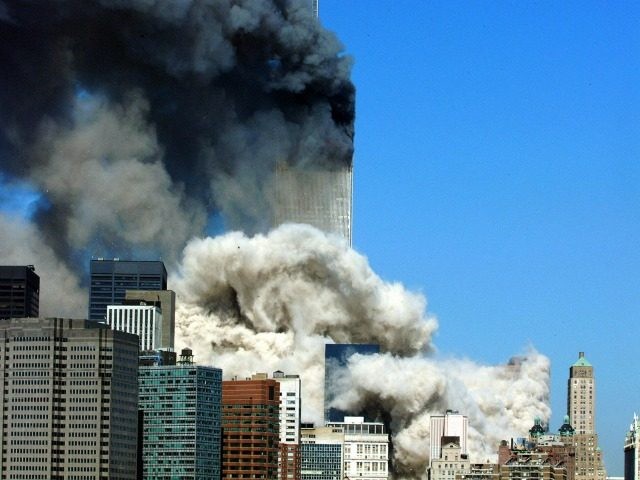Federal agencies are still refusing to close one the major gaps in the nation’s anti-jihadi defenses, 15 years after 19 Islamic infiltrators murdered 3,000 Americans on 9/11.
That major gap was spotlighted after the 9/11 atrocity by a government advisory group — but it has not been fixed because neither President George W. Bush nor President Barack Obama wanted to close the gap, or overcome the vigorous opposition of lobbies eager for cheap immigrant labor and more customers.
The gap is the refusal of the federal government to mark and record the routine departure of visiting foreigners from the United States. Two of the 19 killers had overstayed their visas before the 9/11 attack. Had they been noticed and then tracked down, the feds might have unveiled the plot before the hijackers got on board the aircraft.
That “overstay” problem was identified after 9/11, and there was much apparent government support for quickly fixing the problem with commercial technology. But since then, according to a person who helped identify the problem after the attack, “we’ve definitely moved backwards.”
The federal government has deployed technology to photograph and properly identify foreigners who enter the United States. That greatly help the federal government find visitors if there is a reason to investigate them after they arrive. For example, the Pakistani jihadi who helped kill 14 Americans in San Bernardino, California, in December 2015, was photographed and identified by the new system when she entered the country as the new wife of a U.S-born jihadi.
But the government refused to also deploy gear that would also record the exit of foreign visitors, so the government literally doesn’t know who is illegally staying in the United States, long past the terms of their temporary visa.
“That visa exit controls were not put in place when the visa entry controls [were deployed] was a failure of both the [George W.] Bush and the President Barack Obama] administrations,” said Brian Zimmer, president of Keeping IDentities Safe, which is pushing for national use of secure drivers’ licenses.
Other gaps — including the existence of lax state laws that helped the jihadis get drivers’ licenses – are being being closed, albeit slowly and incompletely. On licenses, “The federal government keeps kicking the can down the road,” said Mark Krikorian, director of the Center for Immigration Studies.
The absent exit system means that almost half a million people can overstay their visas each year, at minimal risk or cost to them. Although many of those visitors do leave after a while, many others try to burrow into American society, find jobs and claim some form of legal residency. Estimates suggest that almost half of the roughly 11 million illegals in the nation arrived legally, and overstayed their visas.
The population of 11 million illegals, along with the annual inflow of roughly 2 million legal immigrants, guest workers, refugees and new illegal immigrants, creates a huge reserve of workers, forces down wages and pushes millions of young Americans out of work.
In 2015, 50 million people visited the United States for business or tourism. Roughly 480,000 visitors overstayed their visas. Obama’s pro-migration policies ensure that only 2,500 overstays were sent home in 2015, down from 12,500 repatriations in 2009.
That’s all good news for businesses who are happy to sell products and service to the overstays, and good news for employers, who are happy to have a larger supply of potential employees.
Those economic reasons help explain why politicians don’t force the airlines and airports to make passengers identify themselves as they leave the country. In fact, the 2013 immigration bill tried to rollback existing law by eliminating the existing legal requirement that federal officials track people as they leave via airports and land routes to Canada or Mexico.
But there’s some progress in the drivers’ license area, where Secretary Jeh Johnson, head of the Department of Homeland Security, is nudging states towards full compliance with the 2005 Real ID law, which was passed to prevent future jihadis from getting fake drivers’ licenses.
For example, the Department of Defense will soon require upgraded drivers’ licenses to be presented by all visitors seeking to enter military bases. That new bar will put more pressure on state legislatures to mandate the use of upgraded licenses in their state. Johnson at DHS “has moved the Real ID Act enforcement forward in states and within the government in a forthright manner,” said Zimmer. It is “a welcome change from the indifference and lassitude” of his predecessor, he added.
“Real ID compliance today has largely been a matter of voluntary compliance by states who understood the importance of secure IDs for public safety and national security,” said Zimmer.
Three states — Washington, Minnesota and Missouri — are still pushing back against the use of enhanced ID, but a variety of other states — including California and North Carolina — are gradually implementing the new system. More than 20 states have upgraded their drivers’ licensing system, including Florida and Colorado.
However, the Real ID law has major loopholes, which were largely imposed by business lobbyists to help illegal immigrants get lower-grade drivers’ licenses. Employers want their workers to have the licenses so they can drive to and from the workplace.
That problems is worsened by the administration’s reluctance to enforce immigration laws, said Krikorian. “The border patrol is releasing 80 percent of the people they’re apprehending, and the administration is doing everything it can to increase the admission of foreigners from abroad — through parole, through increased refugees settlements and just waiving Central Americans across the Rio Grande,” he said.



COMMENTS
Please let us know if you're having issues with commenting.